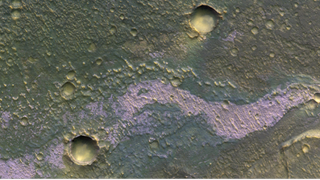Mars orbiter hears the siren song of a salty Red Planet 'mermaid'
Salt deposits in what was once a water-rich area on Mars known as the "Sea of the Sirens."

The European Space Agency (ESA) has released images of a 'salty purple mermaid' on Mars' surface.
The purple wave gleaming amongst the reds, browns, and greys on the surface of Mars was captured ESA's ExoMars Trace Gas Orbiter (TGO) during a flyby in 2022. The 'mermaid' is located in a dried-up riverbed in the planet's southern hemisphere, in a region known as Terra Sirenum — Latin for 'Sea of the Sirens'.
"A purplish, scaly wave lures the attention of a European spacecraft as it flies over," ESA wrote in a statement accompanying ExoMars' image. "It is just an optical illusion – there are no mythological mermaids or seas on the Martian world today," the space agency added.
The purple anomaly was determined to be chloride salt deposits by the orbiter's Color and Stereo Surface Imaging System (CaSSIS) — a high-resolution camera that captures color stereo images of Mars' surface features.
Stereo imaging works by capturing multiple images of the same surface feature from slightly different angles, allowing software to analyze the parallax effect — the apparent shift in position between the images — to calculate the depth and create a detailed 3D model of the terrain. This allows scientists to carry out detailed studies of the Red Planet's topography and geological processes from afar.
Chlorine-rich minerals were identified as the source of the purple wave. The chloride deposits show up as a distinct purple hue in TGO's color-infrared images, making CaSSIS a unique tool to study the distribution of salts across Mars. These deposits indicate the presence of water, once abundant on Mars.
However, due to the planet's lack of a magnetic field, Mars' atmosphere slowly eroded away, carrying off most of its water. As the water vanished, it left behind mineral deposits like this one, serving as a fingerprint of its former presence.
Get the Space.com Newsletter
Breaking space news, the latest updates on rocket launches, skywatching events and more!
Remaining salt deposits, such as our purple mermaid, may provide evidence for the existence of former Martian life — and are thus a good place for future surface explorers to begin their search.
"Very salty waters could have become a haven for life, a beacon for habitable places on Mars," the ESA team wrote in the statement. "High concentrations of salt allow water to remain liquid at temperatures as low as –40 ºC. The chloride deposits in this picture and its direct relation to liquid water make areas such as Terra Sirenum good targets for future robotic missions searching for signs of life."
Join our Space Forums to keep talking space on the latest missions, night sky and more! And if you have a news tip, correction or comment, let us know at: community@space.com.

A chemist turned science writer, Victoria Corless completed her Ph.D. in organic synthesis at the University of Toronto and, ever the cliché, realized lab work was not something she wanted to do for the rest of her days. After dabbling in science writing and a brief stint as a medical writer, Victoria joined Wiley’s Advanced Science News where she works as an editor and writer. On the side, she freelances for various outlets, including Research2Reality and Chemistry World.
-
NilesCanada It's been 45 years since I took Latin, but I seem to recall that Terra Sirenum would be "Land of the Sirens." Mare Sirenum would be "Sea of the Sirens." ?Reply
Separately, a Siren is a bird-like creature (who lives on land) with the head of a girl. Their songs lured unwary seafarers onto the rocks as prey.